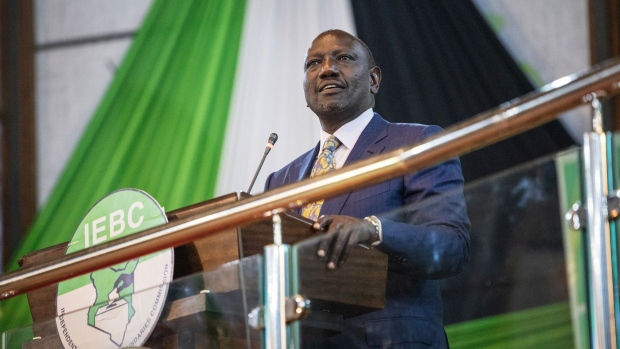Sep 29, 2022
Kenya’s Ruto Proposes 9% Spending Cut in Maiden Speech to Parliament
, Bloomberg News

(Bloomberg) -- Kenyan President William Ruto has asked his government to find ways for cutting budgeted spending by at least 9% this fiscal year.
In his maiden speech to parliament as the leader of East Africa’s biggest economy, Ruto proposed reducing spending by 300 billion shillings ($2.49 billion) in the year through end-June, nearly half of its development budget.
“Our financial situation is not very good,” he said. “The market cannot sustain the borrowing we are doing as government.”
Slashing public spending and borrowing were key campaign promises by Ruto, who said the measures were necessary to free up resources for tackling debt. Repayment of public loans took up 57% of tax income in the previous fiscal year.
The Treasury had earmarked 3.34 trillion shillings expenditure for this year, and intended to borrow 900 billion shillings to cover both development and recurrent spending. His administration will seek to eliminate borrowing for expenses such as salaries within three years.
“The government should never borrow to finance recurrent expenditure,” Ruto said. “It is not right, it is not prudent, it is not sustainable, it is simply wrong. We must bring our country back to sanity.”
The Treasury used almost 18% of borrowed money in the period ended June 2022 on recurrent spending such as Covid-19 vaccines and cushioning low-income members of the society hurt by the economic fallout from the pandemic, it said.
Debt Distress Risk
Kenya is at high risk of debt distress, according to the International Monetary Fund. Reducing that vulnerability is a central goal of a 38-month program the nation signed up with the lender. Kenya’s debt increased more than four-fold to 8.58 trillion shillings under Ruto’s predecessor, Uhuru Kenyatta, with significant investment in new rail links and other infrastructure.
While public debt servicing costs are seen surging by a third to 1.39 trillion shillings, the Treasury expects to collect 2.1 trillion shillings this fiscal year. “This is only enough to pay debt and to pay salaries. Everything else, we have to borrow,” Ruto said.
The financing gap is equivalent to 6.1% of gross domestic product, and is seen narrowing to 4.4% in the following 12 months, according to Treasury.
Other Highlights:
- The government will propose measures to increase taxes paid by the wealthy to try make the system more equitable.
- It also intends to overhaul social infrastructure, with plans to match the private sector’s employee pension contributions by 50% for a maximum 3,000 shillings annually.
- To increase access to water to 80% of the population from 60%. That will require about 500 billion shillings, an amount the government can’t afford all at once and will seek to partner with the private sector, Ruto said.
©2022 Bloomberg L.P.






